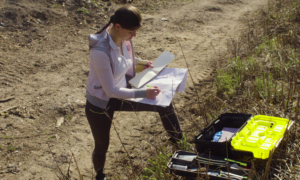
During a session on disproportionate minority contact, youth audience members participate in a mock justice system processing activity facilitated by Tshaka Barrows of the W. Haywood Burns Institute.
WASHINGTON, D.C. — As a teen, Miguel Rodriguez used graffiti to express himself and “to prove to the world that he existed,” the now 20-year-old told Youth Today. But, at age 13 his interest in graffiti turned into a vandalism arrest, where he spent several weeks in detention and 18 months on probation.
Since then, Rodriguez has used graffiti to engage his peers on social justice issues, as program director for the Graffiti Zone, a Chicago-based after-school program and as a member of the youth advisory board of the Illinois Juvenile Justice Commission.
Rodriguez was one of approximately 115 youth and young adults between the ages of 16 and 30, from 27 different states who descended upon the D.C.- based law firm Patton Boggs this weekend to participate in the Coalition for Juvenile Justice’s summit, Empowering Young Leaders for Juvenile Justice Reform.

The summit, which included youth advisory meetings and presentations on a range of hot button juvenile justice topics, such as disproportionate minority contact and the school-to-prison pipeline, aimed to cultivate a young, new and invigorated body of juvenile justice reformers.
At a session on youth organizing and advocacy, Rashad Hawkins, youth organizer at Just Kids Partnership told audience members that “there are three ways to engage youth” in justice advocacy…“but the first two aren’t effective.” The “parrot” and “youth-led” models, Hawkins explained, don’t work because the first only uses young people as “parrots” to repeat adult messages and the second doesn’t give kids any mentorship or support from adults. “Youth-adult partnerships” are the most effective, he said, because young people lead with their messages and adults follow with resources, professional development and accountability measures.
Hawkins urged participants to think strategically about how they want to effect change and to remember that advocacy doesn’t necessarily involve conflict. “Youth organizing is not a new concept,” added Tanesha Ingram, youth and community coordinator at the Correctional Association of New York. Young people must remember that it’s their right to tell adults what they need and want; and when they realize this approach isn’t new, it doesn’t feel as daunting, she added.
In walking through the steps of how to organize and advocate, Hawkins advised young participants to:
- Set short-term, intermediate and long-term goals;
- Create resource pools of money, in-kind goods and space;
- Identify primary and secondary target individuals that can help implement changes sought;
- Use the media to promote causes; and
- Use tactics, such as events, public hearings or strikes that make sense to the audience.

Hawkins also urged young people to know what they want to say to their targets and how they want to say it. He encouraged the audience to feel empowered in their cause and how they portray themselves as leaders. Use strong, persuasive language when speaking about what you want, he said; steer away from words like “maybe” or “never,” which are defeatist and shed doubt. Ingram echoed Hawkins’ sentiments, reminding the audience that they are their biggest resources and that they know how to do this through their own experiences, whether planning parties or participating in after school club events.
During the summit, youth participants also met to discuss their recommendations to the Federal Advisory Committee on Juvenile Justice (FACJJ). The recommendations, which will be the focus of an August 12th meeting of the FACJJ and ultimately submitted to the president and Congress, focus on ways the Office of Juvenile Justice and Delinquency Prevention (OJJDP) can better engage youth.

Haley Reimbold, FACJJ youth member, presented the draft recommendations to the audience, calling upon each of them to submit written suggestions or changes. Our recommendations, she said, aim to build well-supported structures within the federal government to make our voices heard.
Also facilitating a debrief on the prior evening’s meeting with OJJDP Administrator Robert Listenbee, Reimbold and audience members were energized by what several called his “sincere” interest in engaging youth. They were pleased that he offered concrete ideas and suggestions about how to make their voices heard. Summing up the mood, one youth participant noted that he felt like for the first time “we have the power to influence a new strategy for an entire government agency.”
Miguel Rodriguez couldn’t agree more. Passionate about juvenile justice reform issues since he was just 13, Rodriguez believes CJJ’s summit helps young people build relationships and connect on shared goals and advocacy interests. So many people working in juvenile justice are blindfolded, he said, it is up to young leaders to help take those blindfolds off.
Photo credit: Jessica Kendall
Photo captions, from the second to the top: During a session on disproportionate minority contact, youth audience members participate in a mock justice system processing activity facilitated by Tshaka Barrows of the W. Haywood Burns Institute; Young audience members chat in between sessions at the CJJ Youth Leadership Summit in Washington, D.C.; Haley Reimbold, youth member of the Federal Advisory Committee on Juvenile Justice speaks at the CJJ Youth Leadership Summit in Washington, D.C.





























